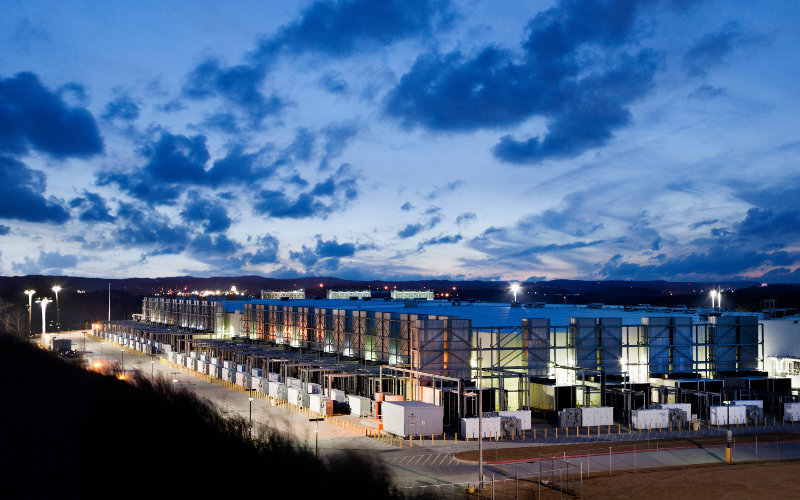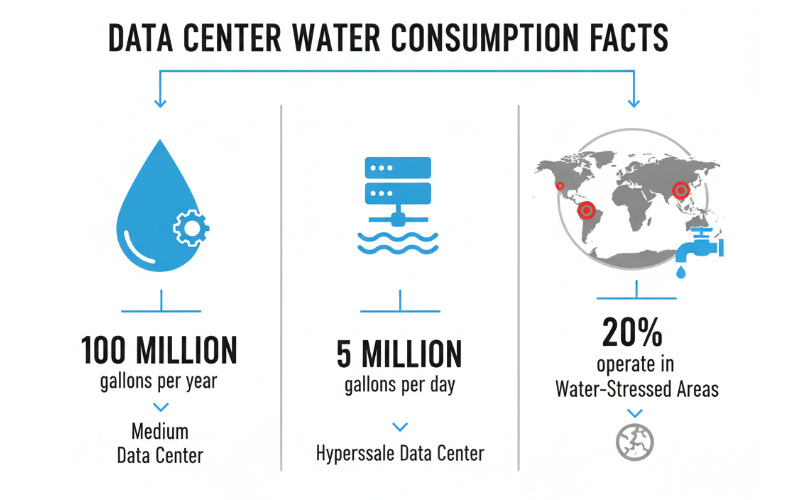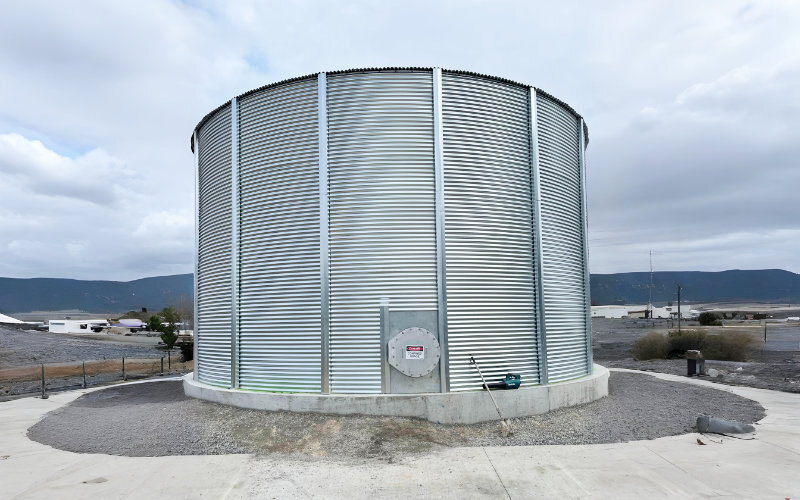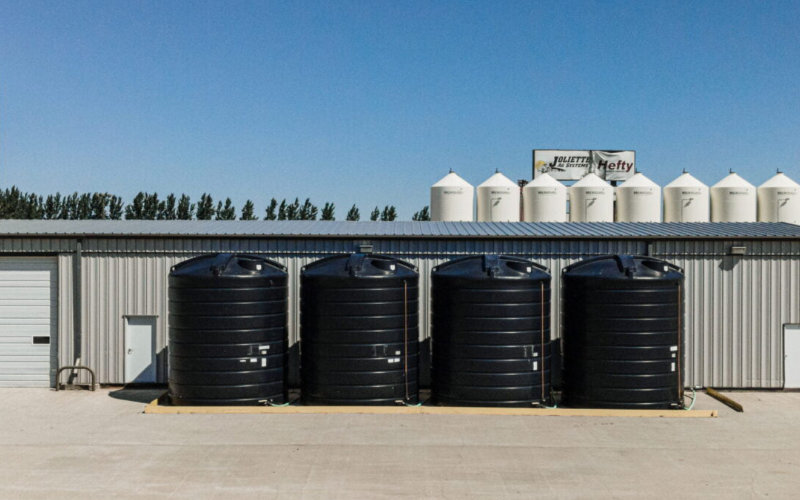In the world of mission-critical infrastructure, data centers face a challenge that often flies under the radar: water management. While most facility managers focus on power redundancy and cooling efficiency, the reality is that water supply is just as critical as electricity for maintaining 24/7 operations. A medium-sized data center can consume over 100 million gallons annually, while hyperscale facilities may use up to 5 million gallons daily – equivalent to an entire town's water needs.
This massive water consumption isn't just about cooling servers. Data centers rely on water for multiple critical functions including humidification control, fire suppression systems, and facility maintenance. When water supply fails, cooling systems fail – and servers can overheat within minutes. That's why forward-thinking facility managers are investing in comprehensive water storage solutions that ensure uninterrupted operations, regulatory compliance, and sustainable resource management.

Modern data centers require sophisticated water management systems to maintain 24/7 operations
Understanding Data Center Water Dependencies
Cooling Systems: The Primary Consumer
The majority of enterprise data centers depend on water-based cooling systems to maintain optimal operating temperatures. In a typical configuration, chilled water loops work in conjunction with cooling towers to dissipate the enormous heat generated by thousands of servers running continuously. This process involves water circulating through chillers to absorb heat from IT equipment, then passing through cooling towers where evaporation carries that heat away.
Key Insight: The concept of "makeup water" is crucial here. As cooling towers evaporate water to reject heat, this lost water must be continuously replaced to maintain system capacity. Additionally, periodic blowdown (drainage to remove mineral buildup) further increases water demand. Without reliable makeup water supply, cooling capacity drops rapidly, putting millions of dollars in equipment at risk.

Typical data center cooling water circuit showing evaporation losses and makeup water requirements
Beyond Cooling: Additional Water Requirements
- Humidity Control: Maintaining 40-60% relative humidity prevents static electricity that could damage sensitive electronics
- Fire Suppression: Wet-pipe sprinkler systems in non-server areas require substantial water reserves
- Facility Operations: General cleaning, maintenance, and domestic uses
- Emergency Reserves: Backup supply for unexpected disruptions or maintenance events
The Growing Challenge of Water Availability
Data centers increasingly face water supply constraints that threaten operational continuity. Approximately one in five U.S. data centers operates in areas experiencing moderate to high water stress, particularly in the arid Western states. This geographic challenge is compounded by aging municipal infrastructure, where main breaks, contamination events, or emergency rationing can interrupt supply without warning.

Data center water consumption continues to grow as digital infrastructure expands globally
Sustainability and Community Impact
The sustainability conversation around data center water usage has intensified dramatically. Some facilities have drawn criticism for consuming up to 25% of a small city's annual water supply, prompting municipalities to demand water-efficient designs and reuse strategies as conditions for approval. This scrutiny has led industry leaders like Google to pioneer the use of recycled municipal effluent for cooling, supported by large on-site storage systems that buffer supply variations.
Water Usage Effectiveness (WUE) has emerged as a critical metric, measuring liters of water consumed per kilowatt-hour of IT energy. While ideal WUE would be zero (achievable only with air cooling in limited climates), most facilities operate above 1.0 – highlighting the significant water overhead required for computing operations.
Engineering Resilience Through On-Site Water Storage
The most effective strategy for ensuring water availability is implementing robust on-site storage systems. Industry best practices recommend designing mission-critical facilities with redundant water feeds plus emergency reserves capable of sustaining operations for 24-48 hours without external supply. For a facility using 2 million gallons daily, this translates to roughly 4 million gallons of storage capacity – a substantial but necessary investment in operational continuity.
Selecting the Right Storage Technology
Various water storage technologies offer different advantages for data center applications
Steel Storage Tanks for High-Capacity Needs

Corrugated galvanized steel tanks and large panel bolted steel tanks provide the backbone of data center water storage. These robust solutions can be engineered to NFPA-22 standards and scaled from thousands to millions of gallons. Factory-coated for corrosion resistance and assembled on-site, steel tanks offer the durability and longevity essential for permanent installations supporting cooling tower makeup water or fire protection reserves.
Fiberglass Tanks for Flexible Installation

When space constraints or chemical compatibility are concerns, fiberglass reinforced plastic (FRP) tanks offer unique advantages. These lightweight, corrosion-proof solutions can be assembled in tight indoor spaces or on rooftops – critical for urban data centers with limited footprints. Modular FRP panel tanks excel in thermal energy storage applications, where chilled water is stored during off-peak hours for use during peak cooling demand.
Polyethylene Tanks for Secondary Systems

High-density polyethylene tanks serve essential roles in supporting infrastructure. From day tanks feeding water treatment systems to condensate collection and chemical storage, these seamless, chemically resistant containers provide cost-effective solutions for volumes ranging from hundreds to several thousand gallons. Their ease of installation and relocation makes them ideal for evolving facility needs.
Flexible Bladder Tanks for Rapid Deployment

Emergency preparedness often requires solutions that can be quickly deployed. Heavy-duty bladder tanks provide temporary or emergency water storage that can be rolled out on any flat surface. During construction, retrofits, or crisis situations, these puncture-resistant fabric tanks offer capacities from hundreds to tens of thousands of gallons without the transportation challenges of rigid tanks.
Fire Protection Water Storage: A Critical Safety Layer
While server rooms typically employ waterless suppression systems, the broader facility requires traditional fire protection meeting strict NFPA standards. Data center campuses, especially those in remote locations or areas with inadequate municipal pressure, must maintain dedicated fire water reserves to ensure instant availability during emergencies.
NFPA-compliant fire protection tanks represent a critical investment in safety and code compliance. These specialized systems include essential components such as anti-vortex suction fittings, fire department connections, level indicators, and freeze protection systems. Sized typically from several hundred thousand gallons upward, these tanks connect to pumps and sprinkler systems to provide steady, pressurized water flow when seconds count.

Fire protection water tanks must meet strict NFPA-22 standards for mission-critical facilities
Best Practice Integration
Many facilities achieve efficiency by integrating fire water storage with cooling reserves through carefully engineered dual-purpose systems. When properly designed and code-compliant, this approach maximizes infrastructure investment while ensuring both operational and safety needs are met.
Comprehensive Stormwater Management and Erosion Control
Data centers' expansive roofs and paved surfaces create significant stormwater management challenges. Without proper infrastructure, heavy rains can cause flooding, foundation damage, and access road washouts. Regulatory compliance demands sophisticated systems that capture, control, and gradually release rainwater while preventing erosion and sediment pollution.
Space-Efficient Underground Solutions
Where land premiums make traditional detention ponds impractical, underground stormwater tanks and chamber systems provide efficient alternatives. These subsurface solutions can be installed beneath parking areas or landscaping, capturing runoff while preserving valuable real estate for revenue-generating infrastructure.

Underground stormwater management systems maximize land use while meeting regulatory requirements
Turning Challenges into Opportunities
Progressive facilities are implementing rainwater harvesting systems that transform stormwater from liability to asset. Captured roof runoff, when properly treated, can supplement cooling tower makeup water or irrigation needs, reducing municipal water demand while managing stormwater compliance. This dual-benefit approach aligns operational efficiency with sustainability goals.
Supporting these systems, comprehensive erosion control products including silt fencing, sediment traps, geotextile fabrics, and erosion control blankets protect both the facility and surrounding environment during construction and operation.
Building Your Water Resilience Strategy
Assessment and Planning
- Quantify Water Dependencies: Calculate cooling loads, fire protection requirements, and identify all water-dependent systems
- Evaluate Risk Factors: Assess local water stress levels, infrastructure reliability, and regulatory requirements
- Design for Redundancy: Implement N+1 or 2N water supply configurations with appropriate storage buffers
- Plan for Growth: Size systems to accommodate future expansion and increasing density
Technology Selection Criteria
- Capacity Requirements: Current and projected water consumption rates
- Space Constraints: Available footprint for tanks and supporting infrastructure
- Water Quality Needs: Treatment requirements for cooling versus fire protection
- Regulatory Compliance: Local codes, NFPA standards, and environmental regulations
- Integration Capabilities: Compatibility with existing cooling and fire suppression systems
- Maintenance Access: Long-term serviceability and inspection requirements
The Business Case for Water Storage Investment

Water storage infrastructure delivers measurable returns through risk mitigation and operational efficiency
Operational Continuity
Every minute of data center downtime can cost thousands to millions of dollars. Water storage systems provide insurance against cooling failures, with ROI often justified by preventing even a single thermal event. The ability to maintain operations during water supply disruptions protects both revenue and reputation.
Regulatory Compliance
Meeting fire codes, stormwater regulations, and sustainability requirements is non-negotiable. Proper water infrastructure ensures compliance while potentially qualifying for green building certifications and utility incentives.
Sustainability Leadership
Water conservation and reuse strategies demonstrate environmental stewardship, increasingly important for securing social license to operate and attracting sustainability-conscious clients.
Operational Flexibility
On-site storage enables load shifting strategies, such as pre-cooling during off-peak hours, reducing both water and energy costs while improving overall system efficiency.
Engineering Tomorrow's Resilient Data Centers Today
As digital infrastructure becomes increasingly critical to global operations, the facilities housing this technology must evolve to meet unprecedented reliability demands. Water storage and management systems represent a fundamental component of this evolution – as essential as backup power generation and redundant network connections.
The convergence of climate challenges, regulatory pressures, and operational demands makes comprehensive water strategies non-negotiable for modern data centers. By implementing robust storage solutions spanning steel tanks, fiberglass systems, flexible bladders, and stormwater management infrastructure, facility managers can transform water from a vulnerability into a competitive advantage.
Ready to enhance your data center's water resilience? Our team specializes in designing and implementing comprehensive water storage solutions tailored to mission-critical facilities. From NFPA-compliant fire protection tanks to multi-million gallon cooling reserves, we provide the infrastructure that keeps your operations running when reliability matters most.
Discuss Your Water Storage Requirements Download Our Data Center Water Solutions Guide



